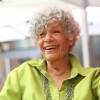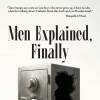Artist Janet Echelman spent more than two years creating her skyline-redefining sculpture, floating above the Rose Kennedy Greenway through early October. A thin, willowy mesh of color and roughly half an acre in size, it soars and breathes the air. The orange, purple and green hues of its fiber glint in the sunlight like a translucent, deep-sea creature. But this is a piece about a neighborhood.
"For me, it was about how to connect the city back to its waterfront," Echelman said.
For 50 years, an elevated highway ran like a gash right through downtown Boston, severing one part of the city from the rest. But when the Big Dig brought the central artery down, the Greenway sprang up.
"My first idea was," Echelman said, "as a kid, I used to play this cats cradle, where you link the twine, and my thought was when the Big Dig allowed the highway to be removed, there was this volume of airspace, and I just wanted to make a cat's cradle across it."
A one-time painter, turned sculptor, the Brookline artist has created installations across the planet working with a team of engineers, architects and designers. Echelman’s sculpture was raised over 10 hours early one Sunday morning. Only then did she give it the title, "As if It were Already Here." Suddenly the piece, with its 100 miles of twine linked by more than half a million knots, became part of the city’s own fabric.
"I was so nervous," she said. "I wanted to crawl under a rock the morning they were taking it up. I was so scared it wouldn’t be right. For me, it’s personally rewarding to see it shared, to see people excited, people taking photos and sharing them. The whole creative inspiration of others was something I hadn’t expected."
But for the Greenway, Lucas Cowan said it’s all according to plan.
"We’re calling it internally our coming-out piece for public art," said Cowan, who's been the Greenway's first public art curator since September 2014.
Art has been a slow brew on the mile-and-a-half-long Greenway. Its most vibrant presence has been the Dewey Square mural that changes annually. The Greenway is developing a five-year public art plan, but Cowan said that includes no permanent pieces.
"It’s not so much based around the museum concept of hanging a painting on a wall," he said. "It’s how you and the public interact. Public art is meant to be touched; it’s meant to be felt, to be experienced."
In June, on the park’s Chinatown parcel, Cowan said the Greenway will unveil a new installation based on the Chinese zodiac signs.
"This year is actually the year of the sheep, so we’ve actually commissioned an artist from New York that is going be bringing up to ten different types of sheep made out of paper that are coated and made sure they are weather resistant," he said. "They’re going to be placed on different platforms which you can walk under and enjoy."
He's made it part of his mission to not take art so seriously.
"Sometimes you just want to take a picture and laugh at it and say, 'Mom, I’m with the sheep.'"
Cowan’s pedigree includes eight years with Millennium Park in Chicago, arguably one of the best cities for public art in the country, with works that are now landmarks in their own right. He said building that sort of public art program takes time.
"Boston’s public art program has been around, but somewhat," he said. "Give us a few years, 10 years, and I think we can somewhat get there."
With the Echelman sculpture, it’s now off to a thunderous start—even if the floating is fleeting.
"It’s like the cherry blossoms," Echelman said. "They are more beautiful because we know they are only here for a moment."
You really do have to see Janet Echelman’s sculpture to appreciate it, and you can in the video version of this story:




